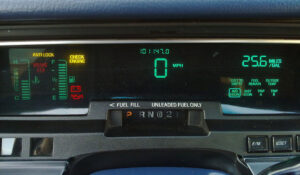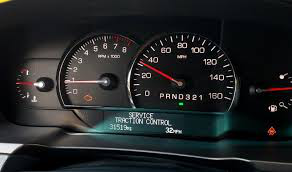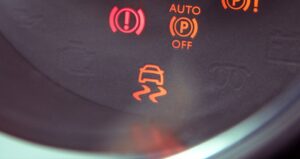
Traction control causes stalling, Traction control system, What happens if we use traction control incorrectly? What are the reasons that can cause stalling of traction control? My Motor Turns Down and My Lights Cut Off while Driving
Traction control system
Traction control systems are meant to help prevent stalling in cars during times of low traction. However, traction control can trick a person into thinking that their brakes are not working. When traction control is activated, the brake lights on the dash might not turn on when braking. This fact could lead people to believe that they have no brakes at all, which could cause them to panic and stall their car.
It is important for drivers to know how traction control works in their car, and when it is appropriate to use it. Traction control should only be used when the car is slipping or sliding. If traction control is activated when the car is not moving, it can actually make the situation much worse. Traction control is meant to be a helpful solution in slippery conditions, not a repetitive one.
Traction control systems use wheel speed sensors and anti-lock brakes in order to determine if traction is low. If traction is lost at any of the four wheels, traction control will become active, reducing power to those wheels by turning off the fuel supply or by applying the brake.
For most cars, traction control is automatically turned on when the car is put into drive or reverse. However, some drivers might choose to turn traction control off in certain situations, like when driving on a snowy road. It is important for drivers to know how their traction control system works so they can make the best decision for the situation.
In some cases, traction control can actually cause a car to stall. When traction is lost, the engine will rev up in an attempt to regain traction. If the traction control system senses this increase in engine speed, it will apply the brakes and stop the car. This can cause a driver to lose control of the car and potentially stall the engine.
It is important for drivers to be aware of the potential dangers of traction control systems. Traction control should only be used when necessary, and drivers should always be aware of their surroundings. Traction control can help keep a car from stalling in slippery conditions, but it can also cause a car to stall if it is activated at the wrong time.
What happens if we use traction control incorrectly?
Traction control is a helpful feature on many cars, but it can also be dangerous if used incorrectly. Drivers should know how traction control works in their car before driving in slippery conditions. Additionally, drivers should always be aware of what traction control does to their car and its engine when activated. Traction control can help prevent a car from stalling, but it can also cause a car to stall if used incorrectly.
What are the reasons that can cause stalling of traction control?
There can be a few different reasons as to why your traction control might be stalling. One possibility is that there is something wrong with the system itself. This could be a problem with the sensors, the computer, or the wiring. If there is something wrong with any of these components, it could prevent the traction control from working properly.
Another possibility is that there is a problem with the way the system works in your vehicle. For example, if you are on slippery or wet roads, it would make sense for your traction control to activate because of these conditions. What happens when this occurs is that the computer tells the engine to slow down and speeds up the braking system so that you don’t skid. What happens when the traction control is activated for long periods of time is that it can’t tell what surface you’re on, and no matter how much braking the computer applies, your wheels won’t stop rotating.
Traction control causes stalling
Vehicle Frameworks That Might Cause Slowing down
Diagnosing a vehicle that passes on while driving or out of gear can be troublesome. The shortcoming might begin in at least one of a few frameworks:
.Fuel framework
.Consumption air framework
.Charging framework
.PCV framework
Record: Diagnosing Your Slowing down Issue
1-An Admonition Light shows up on the Dashboard
2-My Motor Stops and My Lights Cut Off while Driving
3-My Motor Passes on Following a Couple of moments of Activity
4-My Motor Stops When I Arrive at a Stop Light
5-My Motor Stop While Sitting
6-My Motor Stops While Driving, Yet I Can Restart It Once more
7-My Vehicle Out of nowhere Kicks the bucket
8-Getting More Assistance
An Admonition Light Shows Up on the Dashboard
A charging framework issue is one of the most well-known wellsprings of slowing down. Charging frameworks give some admonition when they fall flat. Normally, you’ll see an admonition marker on your dashboard, similar to a:
-battery light
-voltmeter demonstrating under 12 volts
-ammeter showing low current
-charging framework cautioning light
-“Administration charging framework” message
-check motor light
Contingent upon the specific issue, at least one electrical extra won’t work as expected or by any stretch of the imagination.
The indicator(s) might be cautioning you that the charging framework isn’t delivering adequate flow for your battery and other electrical circuits to work accurately. Or then again, that a demonstrative difficulty code has been put away. Frequently, the issue is in the alternator or voltage controller.
When your charging framework falls flat, you might have the option to drive around 30 minutes, on the off chance that your battery is healthy. From that point onward, your battery power will be exhausted and you’ll not be able to restart the motor.
Parts to check:
On some vehicle models, the charging framework might be constrained by the vehicle’s PC or electronic control unit (ECU). For this situation, a charging framework issue will trigger a symptomatic difficulty code. This code can be of incredible assistance when diagnosing a framework issue. In the event that you see the CEL on, download the difficulty codes utilizing a scanner or code per user. Assuming that you don’t have a scanner, your neighborhood automobile parts store might download the codes for you. Nonetheless, assuming the CEL isn’t on, you actually may analyze the issue. Here are a few parts that you might need to check:
Check the battery case for harm.
Really look at the battery terminals and links. The most well-known issue is consumption around the battery posts and terminals, or a free link. Both of these will keep the charging framework from appropriately charging the battery. Likewise, the battery might be broken. So have the battery checked, if vital.
Check the drive belt. A free or worn drive belt might neglect to appropriately charge the battery or run the alternator. Really look at the belt for harm, legitimate change, and review the pulleys for appropriate arrangement.
Check the charging framework circuit, including wires, connectors, wires, and fusible connections.
Have the voltage controller and alternator checked for appropriate activity.
My Motor Turns Down and My Lights Cut Off while Driving
You might see that each time you drive over a knock out and about or take a sharp turn, the radio, lights and motor abruptly stop. This isn’t just disappointing, however, a wellbeing issue.
Following a couple of moments, the motor and the remainder of the electrical adornments might begin working once more. Albeit this might appear as though a devastating issue, the fix can be a basic thing.
What to check :
Connect the stopping brake, turn over the motor, and let it inactive.
-Bust open the hood.
-Squirm the battery links, including the little wire that interfaces with the vehicle’s body, assuming your vehicle has one.
-Assuming that the motor stops and the headlights quit working while you do this, you are managing a free, consumed or frayed link or wire. You’ll have to fix or replace the wire, link or association.
Other potential issues include:
An exhausted or flawed start switch. The headlights will in any case work.
A blown breaker or fusible connection. Your lights and different extras might in any case work, yet the motor may not restart.
My Motor Kicks the bucket Following a Couple of moments of Activity
You start your vehicle and following a couple of moments of driving, the motor stops. The motor won’t turn over until it cools, just to kick the bucket again following a couple of moments of driving. Lights, radios and other electrical parts will in any case
What to check for:
-defective start curl
-awful start module
-defective driving rod position sensor
-terrible fuel siphon engine
Loops and little gadgets in start modules, engines and start curls might create electrical “opens” that won’t appear until the part heats up and wires inside the part extend, making the open show up.
To test for an open loop on an attractive kind driving rod position (CKP) sensor (with a couple of wires) or start curl (on single loop models with a merchant):
-Eliminate the sensor or curl from the vehicle, if essential.
-Test the sensor opposition; or the essential and auxiliary start loop obstruction.
-Contrast your outcomes with the determinations in your vehicle fix manual.
-Heat the sensor or start curling tolerably utilizing a hot compressed air firearm or hair dryer.
-Rehash step number 2.
-On the off chance that the readings vary, or the sensor or start loop peruses, in endless opposition, supplant the part.
My Motor Turns Down When I Arrive at a Stop Light
A motor that slows down when you arrive at a stop light or while sitting might highlight a defective inactive air control solenoid (IAC). The PC utilizes the IAC solenoid to sidestep the choke valve and infuse more air, contingent upon motor working conditions.
A typical issue with air sections in the choke, and the IAC valve itself, is carbon, soil or fuel stain development. Assuming that air can’t go through the air terminals when required, the motor might slow down when you arrive at a stop or while the motor is sitting.
To check the IAC air entries for stopping up:
-Find the IAC around the choke body.
-Turn off the IAC solenoid electrical connector.
-Eliminate the solenoid from the choke body.
-Really take a look at the air sections for carbon development and clean them as essential.
Another conceivable issue, other than stopping up, is that the IAC engine or its circuit might have fizzled.
Assuming you want to test the IAC:
-Eliminate the IAC solenoid from the choke.
-Interface directs battery capacity to the solenoid utilizing jumper wires.
-Assuming the solenoid doesn’t react, supplant it.
The IAC engine can likewise be checked with an ohmmeter. Check your vehicle’s repair manual, if essential.
Different flaws can likewise deceive the PC to work the IAC solenoid when it ought not. For instance, a choke position (TP) sensor that is conveying mistaken messages to the PC might make it close the IAC solenoid when it shouldn’t, slowing down the motor. The TP sensor or its circuit might be broken.
Additionally, contingent upon your specific vehicle make and model, check for a free motor speed sensor or awful sensor, particularly assuming you’ve seen a failure to discharge at driving rates.
Deceleration when coming up to a stop light appears to kill the motor.
My Motor Stops While Sitting
This condition is like the past one, yet the issue here might be more determined. You might even see the check motor light come on. Various parts might make your motor shut off out of gear.
What to check:
Generally, this focuses on vacuum spills, particularly on vehicles with a mass wind current (MAF) sensor:
-brake supporter
-EGR framework or valve stuck open
-PCV valve stuck open
-Admission or choke gasket
On the off chance that your CEL is on, you might get inconvenience codes P0171, P0174 or P0300. Contingent upon your specific model, you may likewise need to investigate the motor speed sensor for a free wire or terrible sensor, particularly assuming you’ve seen a failure to fire while driving.
Likewise, the motor might slow down out of gear when cold. This might highlight a flawed sensor that is sending incorrect information to the PC or a framework with a ragged or defective part.
What to check:
-Awful fuel pressure controller
-Awful MAF sensor
-Broken complex outright tension (Guide) sensor
-Flawed motor coolant temperature (ECT) sensor
-Bombed choke position sensor (TPS)
-Consumption vacuum spill
Frequently, an awful sensor will trigger the check motor light (CEL). Regardless of whether you see the light on, filter your PC for inconvenience codes. A forthcoming code might assist you with zeroing in on a framework or part that might be creating problems.
My motor Stops While Driving However I Can Restart It Once more
Here, the motor might slow down while the vehicle is moving, and, now and again, while standing by. Frequently, the vehicle continuously kicks the bucket. You might feel your vehicle jerk a piece prior to passing on, as though your vehicle has run on empty. The shortcoming might be in the fuel framework.
What to check:
Stopped up fuel channel
Broken fuel pressure controller. You can test for fuel pressure yourself utilizing a fuel pressure measure. Look into the tension determinations for your specific vehicle make and model in your vehicle fix manual. In the event that you don’t have the manual, you can get a somewhat cheaper one from Amazon. Haynes manuals accompany bit-by bit techniques and representations for investigating, upkeep and part substitution projects you can do at home.
Fuel siphon. Assuming that you haven’t replaced the fuel siphon over the most recent ten years, the siphon might be worn and unfit to convey the right measure of fuel the motor requires above inactive rates. Check the fuel siphon in the event that your vehicle slows down when halting at a red light and afterward begins right back up.
My Vehicle Out of nowhere Passes on
Frequently, a vehicle may abruptly bite the dust out and about or while sitting. Not at all like the cases talked about over, this disappointment feels as though the start switch was wound down. Headlights and other electrical extras actually work.
Contingent upon your specific vehicle year and model, the issue can be in the start framework itself, or a sensor your vehicle PC relies upon to keep the start framework working.
What to check:
-Broken driving rod position (CKP) sensor
-Issues in the CKP circuit
-Awful start switch or circuit
-Broken essential start framework. Contingent upon your specific framework, this might include:
-start switch
-Battery
-counterweight resistor
-start loop (single curl with a wholesaler)
-start control module
The issue can highlight terrible contacts in the start switch or another party’s electrical connector. Assuming that the issue keeps the motor from restarting, a part, connector or wire has totally fizzled.
Assuming the issue shows up when the motor heats up and vanishes once the motor has cooled, check segment 3 over, “My Motor Passes on Following a Couple of Moments of Activity.”
Getting More Assistance
There are various reasons that a vehicle may bite the dust while driving or out of gear. A few reasons depend upon your specific model; on different occasions, it is a processing plant issue.
What to check:
Vehicle makers post specialized help releases (TSB) that address an issue with a specific framework or part in a specific model . Also, this might incorporate issues for a vehicle that slows down while driving or out of gear; for instance, a broken PC program or a deficient part utilized in a specific model.


